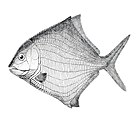Neuburgella is an extinct genus of prehistoric bony fish that lived during the Cisuralian epoch in what is now Kazakhstan.

Rhabdolepis is an extinct genus of prehistoric bony fish that lived during the Asselian age of the Cisuralian epoch in what is now Germany and France (Burgundy).

Sinoniscus is an extinct genus of prehistoric bony fish that lived during the Late Permian epoch.
Inichthys is an extinct genus of prehistoric marine bony fish that lived during the Lopingian epoch. Fossils were recovered in the Kuznetsk Basin, European Russia.
Paralogoniscus is an extinct genus of prehistoric bony fish that lived during the Cisuralian epoch in what is now East Kazakhstan, Kazakhstan. It could reach body lengths of up to ca. 50 cm (20 in).
Tienshaniscus is an extinct genus of prehistoric bony fish that lived during the Lopingian epoch in what is now Xinjiang, China.

Aeduella is an extinct genus of prehistoric freshwater bony fish that lived during the Gzhelian and Asselian-Sakmarian ages in what is now France, Germany, Switzerland and the Czech Republik.
Boreolepis is an extinct genus of prehistoric marine ray-finned fish that lived from the Late Kungurian to the Wuchiapingian of the Permian period. It inhabited the high northern latitudes in what is now Greenland and European Russia.
Charleuxia is an extinct genus of prehistoric freshwater ray-finned fish that lived during the Asselian age in what is now Burgundy, France (Autun). It may possibly belong to the genus Paramblypterus.
Westollia is an extinct genus of prehistoric bony fish that lived during the Asselian age in what is now Thuringia, Germany.
Urosthenes is an extinct genus of prehistoric bony fish that lived during the Lopingian to Middle Triassic epochs in what is now New South Wales, Australia.

Gyrolepis is an extinct genus of prehistoric ray-finned fish from the Middle-Late Triassic epochs in what is now Europe. It is known both from complete specimens and isolated skeletal elements, such as scales or teeth.
Gardinerichthys is an extinct genus of freshwater actinopterygian bony fish from the Cisuralian epoch of Germany, and the middle Permian of India. The type species, G. latus, was discovered in Asselian aged layers (Rotliegend).
Eigilia is an extinct genus of prehistoric bony fish that lived during the Roadian age in what is now Kazakhstan.
Korutichthys is an extinct genus of prehistoric marine bony fish that lived during the Lopingian epoch in what is now Krasnoyarsk Krai, Russia. It was first referred to the family Amblypteridae, a view that was later questioned.
Igornella is an extinct genus of prehistoric bony fish that lived during the Gzhelian (Stephanian) to Asselian ages in what is now France (Burgundy).
Gardinerpiscis is an extinct genus of prehistoric actinopterygian fish that lived during the Kungurian age of the early Permian epoch in what is now Kazakhstan. It was originally named "Gardineria" by Kazantseva-Selezneva (1981). Because this genus name was already given to an extant scleractinian coral, the new name Gardinerpiscis was erected for the Permian fish. The genus includes a single species (monotypy): Gardinerpiscis akkolkensis.
Turseodus is an extinct genus of ray-finned fish found in Late Triassic freshwater sediments of the United States. Two species have been described, T. acutus from the Lockatong Formation of Pennsylvania, and T. dolorensis from the Chinle Formation of Colorado.

Acropholis is an extinct genus of prehistoric marine bony fish that lived during the Wuchiapingian age in what is now Greenland and Hesse (Germany).
Kelliaichthys is an extinct genus of prehistoric bony fish that lived during the Cisuralian epoch in what is now East Kazakhstan, Kazakhstan. It was originally named "Kellia" by Kazantseva-Selezneva (1980). Because this genus name was already given to an extant lasaeid bivalve, the new name Kelliaichthys was erected for the Permian fish. The genus includes a single species (monotypy): Kelliaichthys velox.












